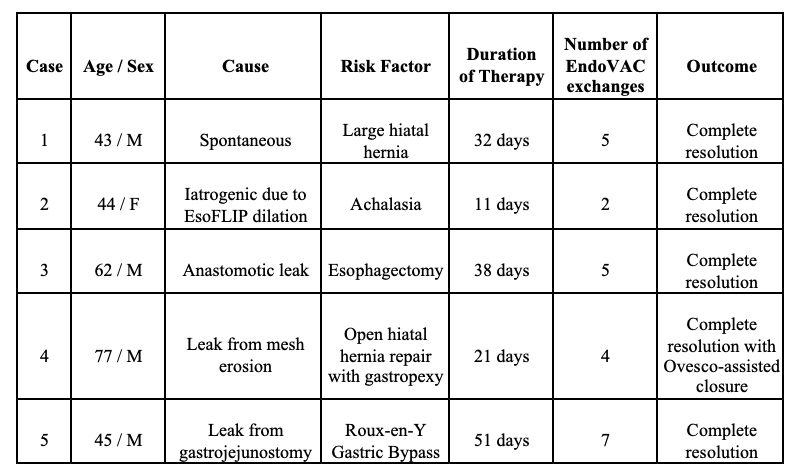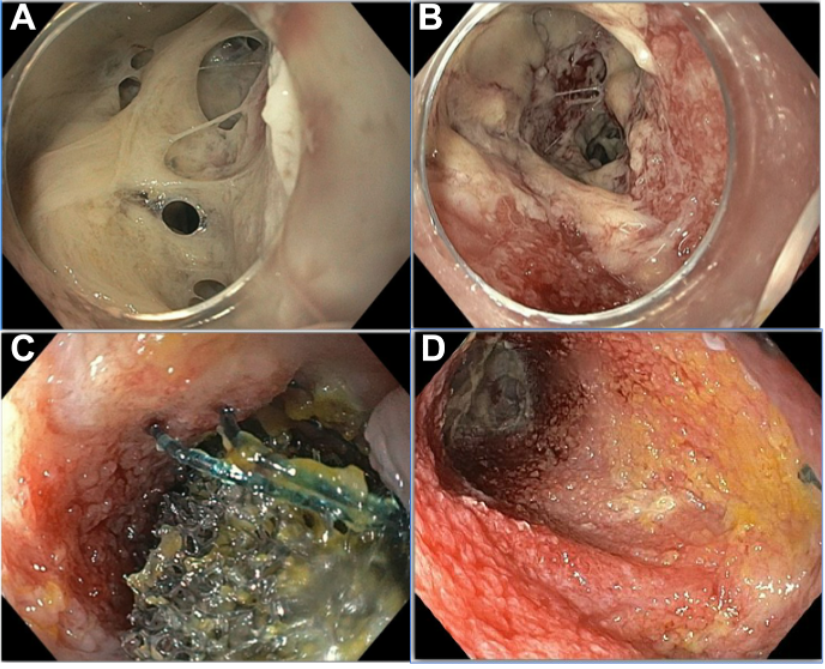Monday Poster Session
Category: Interventional Endoscopy
P3594 - Positive Outcomes With Endoscopic Vacuum-Assisted Closure (EndoVAC) Therapy for Proximal Gastrointestinal Perforations and Mediastinal Leaks: A 5-Case Series
Monday, October 27, 2025
10:30 AM - 4:00 PM PDT
Location: Exhibit Hall

Sevag Hamamah, DO
Scripps Mercy Hospital
San Diego, CA
Presenting Author(s)
Award: ACG Presidential Poster Award
Sevag Hamamah, DO1, Nupur Savalia, MD1, Joy-Marie Hermes, MD2, Evan Wilder, MD2, Sushrut Thiruvengadam, MD2, Matthew Skinner, MD2, Douglas Hunt, MD3, Faizi Hai, MD1
1Scripps Mercy Hospital, San Diego, CA; 2Scripps Green Hospital, La Jolla, CA; 3Scripps Clinic, La Jolla, CA
Introduction: Endoscopic vacuum-assisted closure (EndoVAC) therapy is a minimally invasive approach that promotes efficient healing and defect closure in the setting of proximal gastrointestinal (GI) tract perforation and mediastinal leaks. Negative pressure facilitates secretion drainage, reduces edema, and promotes granulation tissue formation. We present five cases of proximal GI tract perforation successfully managed with EndoVAC, demonstrating its efficacy as both primary and salvage treatment.
Case Description/
Methods: We retrospectively reviewed five patients with proximal GI tract perforations and associated mediastinal leaks stemming from various etiologies including spontaneous ruptures, iatrogenic causes and anastomotic leaks. All cases were treated with EndoVAC, requiring sequential EndoVAC sponge exchanges and negative pressure therapy. Successful defect closure and leak resolution was observed in all five cases, confirmed by endoscopy and upper GI series.
In the first case, patient presented with a spontaneous esophageal perforation in the setting of a large hiatal hernia. Robotic-assisted repair with mediastinal drainage failed due to re-perforation. EndoVAC therapy was successful, requiring 5 EndoVAC exchanges over 32 days. In the second case, patient underwent EsoFLIP dilation for achalasia, complicated by iatrogenic perforation, for which initial closure with endoscopic stenting and suturing failed. Esophageal defect was successfully managed with EndoVAC, requiring 2 exchanges over 11 days. In the third case, patient presented with a post-esophagectomy anastomotic leak, requiring 5 EndoVAC exchanges over 35 days. In the fourth case, patient presented with a leak from mesh erosion after revisional hiatal hernia repair, requiring 4 EndoVAC exchanges over 21 days with assistance from Ovesco closure. In the fifth case, the patient demonstrated a gastrojejunal leak post-Roux-en-Y Gastric Bypass, requiring 7 EndoVAC exchanges over 51 days. Mean treatment duration was 30.6 days (range: 11–51), with a mean of 4.6 exchanges (range: 2–7). No EndoVAC-related complications were observed.
Discussion: This case series highlights successful defect closure and leak resolution across a range of challenging clinical scenarios, including failed surgical and endoscopic interventions. Therefore, EndoVAC therapy offers a reliable approach for managing complex proximal GI tract perforations and mediastinal leaks and can be strongly considered as an early treatment option for primary and refractory cases.

Figure: Figure 1. Stepwise resolution of mediastinitis with successive EndoVAC exchanges in Case 1. A) Initial endoscopic intubation of the esophageal defect revealed significant pus and debris consistent with mediastinitis. B) One week following EndoVAC placement, endoscopy showed partial improvement of mediastinitis. C) EndoVAC sponge visualized within the mediastinum. D) One week before closure, endoscopy revealed near resolution of mediastinitis.

Figure: Table 1. Patient characteristics and case summaries of proximal gastrointestinal tract perforations managed by EndoVAC therapy. Demographic data, cause of perforation, risk factor for perforation, duration of EndoVAC therapy, number of EndoVAC exchanges, and outcomes are included.
Disclosures:
Sevag Hamamah indicated no relevant financial relationships.
Nupur Savalia indicated no relevant financial relationships.
Joy-Marie Hermes indicated no relevant financial relationships.
Evan Wilder indicated no relevant financial relationships.
Sushrut Thiruvengadam indicated no relevant financial relationships.
Matthew Skinner: Boston scientific – Consultant. Microtech – Consultant.
Douglas Hunt indicated no relevant financial relationships.
Faizi Hai indicated no relevant financial relationships.
Sevag Hamamah, DO1, Nupur Savalia, MD1, Joy-Marie Hermes, MD2, Evan Wilder, MD2, Sushrut Thiruvengadam, MD2, Matthew Skinner, MD2, Douglas Hunt, MD3, Faizi Hai, MD1. P3594 - Positive Outcomes With Endoscopic Vacuum-Assisted Closure (EndoVAC) Therapy for Proximal Gastrointestinal Perforations and Mediastinal Leaks: A 5-Case Series, ACG 2025 Annual Scientific Meeting Abstracts. Phoenix, AZ: American College of Gastroenterology.
Sevag Hamamah, DO1, Nupur Savalia, MD1, Joy-Marie Hermes, MD2, Evan Wilder, MD2, Sushrut Thiruvengadam, MD2, Matthew Skinner, MD2, Douglas Hunt, MD3, Faizi Hai, MD1
1Scripps Mercy Hospital, San Diego, CA; 2Scripps Green Hospital, La Jolla, CA; 3Scripps Clinic, La Jolla, CA
Introduction: Endoscopic vacuum-assisted closure (EndoVAC) therapy is a minimally invasive approach that promotes efficient healing and defect closure in the setting of proximal gastrointestinal (GI) tract perforation and mediastinal leaks. Negative pressure facilitates secretion drainage, reduces edema, and promotes granulation tissue formation. We present five cases of proximal GI tract perforation successfully managed with EndoVAC, demonstrating its efficacy as both primary and salvage treatment.
Case Description/
Methods: We retrospectively reviewed five patients with proximal GI tract perforations and associated mediastinal leaks stemming from various etiologies including spontaneous ruptures, iatrogenic causes and anastomotic leaks. All cases were treated with EndoVAC, requiring sequential EndoVAC sponge exchanges and negative pressure therapy. Successful defect closure and leak resolution was observed in all five cases, confirmed by endoscopy and upper GI series.
In the first case, patient presented with a spontaneous esophageal perforation in the setting of a large hiatal hernia. Robotic-assisted repair with mediastinal drainage failed due to re-perforation. EndoVAC therapy was successful, requiring 5 EndoVAC exchanges over 32 days. In the second case, patient underwent EsoFLIP dilation for achalasia, complicated by iatrogenic perforation, for which initial closure with endoscopic stenting and suturing failed. Esophageal defect was successfully managed with EndoVAC, requiring 2 exchanges over 11 days. In the third case, patient presented with a post-esophagectomy anastomotic leak, requiring 5 EndoVAC exchanges over 35 days. In the fourth case, patient presented with a leak from mesh erosion after revisional hiatal hernia repair, requiring 4 EndoVAC exchanges over 21 days with assistance from Ovesco closure. In the fifth case, the patient demonstrated a gastrojejunal leak post-Roux-en-Y Gastric Bypass, requiring 7 EndoVAC exchanges over 51 days. Mean treatment duration was 30.6 days (range: 11–51), with a mean of 4.6 exchanges (range: 2–7). No EndoVAC-related complications were observed.
Discussion: This case series highlights successful defect closure and leak resolution across a range of challenging clinical scenarios, including failed surgical and endoscopic interventions. Therefore, EndoVAC therapy offers a reliable approach for managing complex proximal GI tract perforations and mediastinal leaks and can be strongly considered as an early treatment option for primary and refractory cases.

Figure: Figure 1. Stepwise resolution of mediastinitis with successive EndoVAC exchanges in Case 1. A) Initial endoscopic intubation of the esophageal defect revealed significant pus and debris consistent with mediastinitis. B) One week following EndoVAC placement, endoscopy showed partial improvement of mediastinitis. C) EndoVAC sponge visualized within the mediastinum. D) One week before closure, endoscopy revealed near resolution of mediastinitis.

Figure: Table 1. Patient characteristics and case summaries of proximal gastrointestinal tract perforations managed by EndoVAC therapy. Demographic data, cause of perforation, risk factor for perforation, duration of EndoVAC therapy, number of EndoVAC exchanges, and outcomes are included.
Disclosures:
Sevag Hamamah indicated no relevant financial relationships.
Nupur Savalia indicated no relevant financial relationships.
Joy-Marie Hermes indicated no relevant financial relationships.
Evan Wilder indicated no relevant financial relationships.
Sushrut Thiruvengadam indicated no relevant financial relationships.
Matthew Skinner: Boston scientific – Consultant. Microtech – Consultant.
Douglas Hunt indicated no relevant financial relationships.
Faizi Hai indicated no relevant financial relationships.
Sevag Hamamah, DO1, Nupur Savalia, MD1, Joy-Marie Hermes, MD2, Evan Wilder, MD2, Sushrut Thiruvengadam, MD2, Matthew Skinner, MD2, Douglas Hunt, MD3, Faizi Hai, MD1. P3594 - Positive Outcomes With Endoscopic Vacuum-Assisted Closure (EndoVAC) Therapy for Proximal Gastrointestinal Perforations and Mediastinal Leaks: A 5-Case Series, ACG 2025 Annual Scientific Meeting Abstracts. Phoenix, AZ: American College of Gastroenterology.

